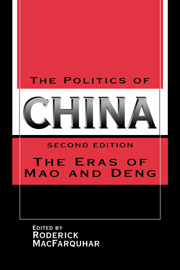Book contents
- Frontmatter
- Contents
- Preface
- List of tables and maps
- List of abbreviations
- Introduction
- 1 The establishment and consolidation of the new regime, 1949–57
- 2 The Great Leap Forward and the split in the Yan'an leadership, 1958–65
- 3 The Chinese state in crisis, 1966–9
- 4 The succession to Mao and the end of Maoism, 1969–82
- 5 The road to Tiananmen: Chinese politics in the 1980s
- 6 Reaction, resurgence, and succession: Chinese politics since Tiananmen
- Appendixes: Leaders and meetings
- References
- Index
Preface
Published online by Cambridge University Press: 05 June 2012
- Frontmatter
- Contents
- Preface
- List of tables and maps
- List of abbreviations
- Introduction
- 1 The establishment and consolidation of the new regime, 1949–57
- 2 The Great Leap Forward and the split in the Yan'an leadership, 1958–65
- 3 The Chinese state in crisis, 1966–9
- 4 The succession to Mao and the end of Maoism, 1969–82
- 5 The road to Tiananmen: Chinese politics in the 1980s
- 6 Reaction, resurgence, and succession: Chinese politics since Tiananmen
- Appendixes: Leaders and meetings
- References
- Index
Summary
The aim of this book is to provide a comprehensive account of the politics of the People's Republic of China from 1949 to the mid-1990s. The first four chapters, covering the years 1949–82, are drawn from Volumes 14 and 15 of the Cambridge History of China (CHOC). The fifth and sixth chapters were specially commissioned to extend the story of Chinese politics through the mid-1990s.
The chapters drawn from CHOC are part of an integrated schema that includes chapters on economics, education, culture, society, and foreign policy, but since “politics took command” of everything in Mao's China, these chapters on politics touch on those other topics as well.
Readers of CHOC will detect one important modification of the chapters that appeared there: The romanization of Chinese terms has been changed from the formerly almost universal Wade-Giles system to the pinyin one, the official system on the Chinese mainland. A desire for consistency throughout CHOC dictated the earlier decision, taken before pinyin became widespread; a recognition that today most books on and students of contemporary China use only pinyin made a change on republication seem sensible. A few hardy perennials of the old system remain; for instance, it seemed appropriate to continue to refer to the Nationalist Party by the familiar KMT and to accept the inconsistency of spelling it out as “Guomindang.” Nancy Hearst, the librarian of Harvard's John King Fairbank Center for East Asian Research, painstakingly undertook the time-consuming tasks of ensuring the accuracy of the changeover and of adapting and expanding the bibliography from CHOC Volumes 14 and 15.
- Type
- Chapter
- Information
- The Politics of ChinaThe Eras of Mao and Deng, pp. viiPublisher: Cambridge University PressPrint publication year: 1997

